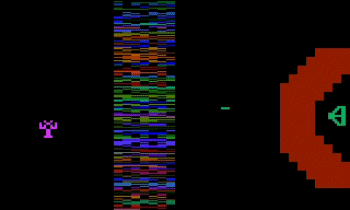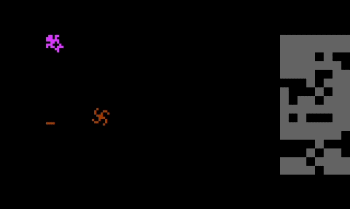
The starting screen with (from left-to-right) the Yar, neutral zone, destroyer missile, the first of two shield (a static semi-halo) and, of course, the Qotile.
Review by Jay Wilson The weird thing about Yar’s Revenge is that it bores the hell out of me right around the time I flip the score counter which only has six digits, and yet every few months I find myself compelled to come back to its simple and charming (albeit repetitive) gameplay. You take control of the Yar which much resembles an insect (flapping wings and all), and the goal across these infinite levels is to destroy the Qotile forever hovering on the right side of the screen behind a shield. Getting rid of the shield is easy enough—your shots destroys large chunks and flying up into it and “eating” it gets rid of smaller chunks but racks up points faster. By touching the Qotile or eating part of its shield, the player may summon the “Zorlon Cannon” to finally take out the Qotile and advance to the next level. Meanwhile the enemy’s destroyer missile (which looks like a hyphen) forever pursues the Yar, and occasionally the Qotile will change into Swirl form and launch itself on a collision course with the Yar. A multi-colored neutral zone runs down the screen and provides a safe haven from the missile (but not the Swirl); however, the neutral zone proves to be more of an annoyance as it also prevents your Yar from firing. And that’s the basics in a nutshell. I love the idea of Yar’s Revenge, and I certainly love its aesthetics. Aesthetics on an Atari 2600 title? Actually, yes. Yar’s Revenge made the most of its limited hardware becoming one of the first games to create atmosphere. Take for example the sound design where most Atari games used a series of beeps, bloops, and blips to represent sounds of frogs crossing freeways, pac-men eating pellets, and monkeys throwing barrels. Yar’s Revenge uses an ominous series of hums, one of which forever oscillating like a Jacob’s Ladder. When the Swirl gets ready to attack, listen to the siren-like alarm right before the Swirl ‘roars’ across the screen after you. And when you take out the Qotile, watch as the whole screen lights up with video games’ first full-screen explosion. And does the Qotile just go boom? Nope. Listen to the wicked echo effect as the explosion fades out and we advance to the next level. 
Notice the small multicolor block on the far left of the screen right next to the Yar. That’s the Zorlon cannon. Use it to kill the Qotile/Swirl, but be careful because it can kill you too.

The second shield type is a dynamic rectangle made up of constantly-moving blocks which, theoretically, makes it harder to hit the Qotile. If you’re aiming for mid-flight Swirls, however ...

Sometimes the neutral zone goes away. Thank God. Since you can’t fire the Zorlon Cannon inside it, it actually becomes a nuisance when you’re trying to out manuever and kill an attacking Swirl that’s faster and tracks.
Terribly primitive? Of course. But at least Yar’s Revenge made the effort. Talk to anyone who played it during Atari’s reign, and they’ll remember the sights and sounds of Yar’s Revenge. Unfortunately, the problem with Yar’s Revenge is two fold. First, with advanced knowledge of the game, the beginning stages feel like an unnecessary grind to get to the fun part. Early on, the enemy missile crawls across the screen, the Swirl comes rarely, and the Yar basically has free reign to attack at its leisure. There’s really no threat. As Qotiles go down and the stages advance, the destroyer missile gets faster but it’s always a minor annoyance at best. The real focus of the game is the Qotile and the Swirl. Now, at the start of the game, an attentive player will notice the Qotile and its missile change colors from blue to green to yellow to orange. A more attentive player will notice the Swirl comes only when the Qotile turns orange, thus they can anticipate its attack. This is important because destroying the Qotile in Swirl form doubles the points. Destroy the Swirl in mid-attack as it flies across the screen? Sextuple points plus an extra Yar. So, theoretically, you can get an extra Yar every single screen (although you can only have nine Yars at any given time.) At those early stages, the Swirl comes occasionally and fires in a random direction, making it difficult to shoot down and, honestly, poses more of a threat of you accidentally running into it. As you rack up points, the Qotile’s shield changes color, signifying a different attack pattern. The game really doesn’t start to pick up or become engaging until the blue shield which means the Swirl comes three times as often (at blue, greenish-yellow, and orange) and tends to fire less randomly (direction wise) making it a little easier to hit. At this stage, you’re constantly flying to the shield to wittle away at it and arm the Zorlon cannon, then almost immediately retreating to the far side of the screen in preparation of the Swirl’s attack. Next, the gray shield is both a step forward and a step back going back to the original attack frequency (only orange), however, it gains the frightening ability to track the Yar with up to two turns which, coupled with its far superior speed, means a swift series of deaths for the unprepared. However, all is not lost. The player has an overwhelming advantage in that the Yar—and only the Yar—can fly through the bottom of the screen and appear at the top (and vice versa). The Destroyer missile? Nope. It has to cross the entire screen. As for the Swirl? It can change directions, but it can’t backtrack. Meaning if the Yar can get behind the Swirl, it’s safe. How do you beat the Swirl’s speed? Fly through the bottom of the screen; it has to change directions and cross the entire screen to hit you. How do you beat its tracking? After you fly through the screen’s edge, simply get behind the Swirl. It can’t follow. More importantly, though, a tracking Swirl allows you to consistently predict where it will be, meaning you can reliably hit it mid-flight with your Zorlon Cannon while safely evading it, racking up an abundance of extra Yars and points. 
Notice the vertical black streak amidst the full-screen explosion. After shooting down a Swirl, immediately line up the back of the Yar with it to get the game-ending easter egg.

Yar’s Revenge’s infamous easter egg. Designer Howard Scott Warshaw’s mirrored initials.
Usually if you can survive the grey shield, the pink and final shield becomes a breeze as the only difference is the Swirl comes at triple frequency (blue, greenish-yellow, and orange) again which means you’re going to be shooting down Swirls a lot faster. Which brings me to the second problem with Yar’s Revenge: there’s not enough variety. Once you’ve mastered the grey shield, there’s really no reason to play. If you do, the game eventually cycles back to the original red shield and works back up to pink ... and after the constant onslaught of tracking Swirls, a non-tracking “once in a blue moon” swirl grinds the game to a near halt (even if the destroyer missile still tracks at full speed.) Some might argue that the game’s easter egg poses a problem, and at one time I would have agreed. During the full-screen explosions, you’ll notice a black vertical streak where the Swirl/Qotile last was. If you align the back of the Yar with this streak, in place of your score the game will display the designer’s initials and ... end the game. Very infuriating because it’s easy to line up shooting down Swirls, and after shooting down hundreds of those damn things you kinda stop paying attention to where your Yar is during the explosion, and it only takes one accidental alignment to bring your record-breaking winning streak to a halt. Now, though? I figure it’s just as well. If you know what you’re doing, you can literally play the game forever, and you’d stop eventually on account of boredom. Might as well stop on account of an easter egg. | ||||||||||||||||||||
|
| ||||||||||||||||||||
